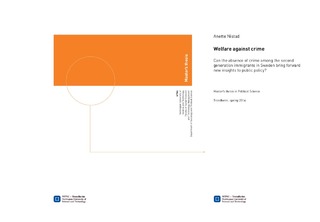| dc.contributor.advisor | Moses, Jonathon | nb_NO |
| dc.contributor.author | Nistad, Anette | nb_NO |
| dc.date.accessioned | 2014-12-19T14:36:43Z | |
| dc.date.available | 2014-12-19T14:36:43Z | |
| dc.date.created | 2014-08-22 | nb_NO |
| dc.date.issued | 2014 | nb_NO |
| dc.identifier | 739913 | nb_NO |
| dc.identifier.uri | http://hdl.handle.net/11250/268808 | |
| dc.description.abstract | In both Europe and the United States, researchers have found the second generation immigrants to commit more crime compare to the first, despite the fact that the second generation is expected to be better off. This thesis explores the ‘Swedish Exception’ to this‘ Immigration Paradox’ as was discovered by Ahlberg (1996) and Martens and Holmberg (2005).Reviewing the evidence of the Swedish Exception, deduced the hypothesis whether the uniqueness of the Swedish welfare state could have caused this change. Positive effects by early childhood intervention programs and its potential for crime reduction is tested by a double application of Mill’s Method of Difference. The thesis concludes that the presence of preschools in Sweden could not have caused the Swedish exception, but it is likely that emphasis on early language education did. Further research is, however, needed. | nb_NO |
| dc.language | eng | nb_NO |
| dc.publisher | Norges teknisk-naturvitenskapelige universitet, Fakultet for samfunnsvitenskap og teknologiledelse, Institutt for sosiologi og statsvitenskap | nb_NO |
| dc.title | Welfare against crime: Can the absence of crime among the second generation immigrants in Sweden bring forward new insights to public policy? | nb_NO |
| dc.type | Master thesis | nb_NO |
| dc.contributor.department | Norges teknisk-naturvitenskapelige universitet, Fakultet for samfunnsvitenskap og teknologiledelse, Institutt for sosiologi og statsvitenskap | nb_NO |
